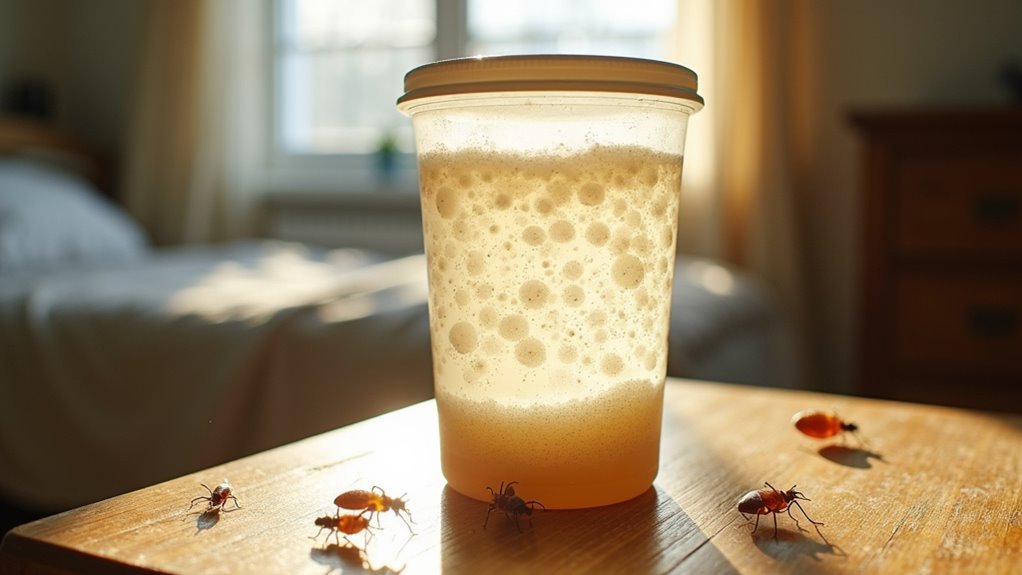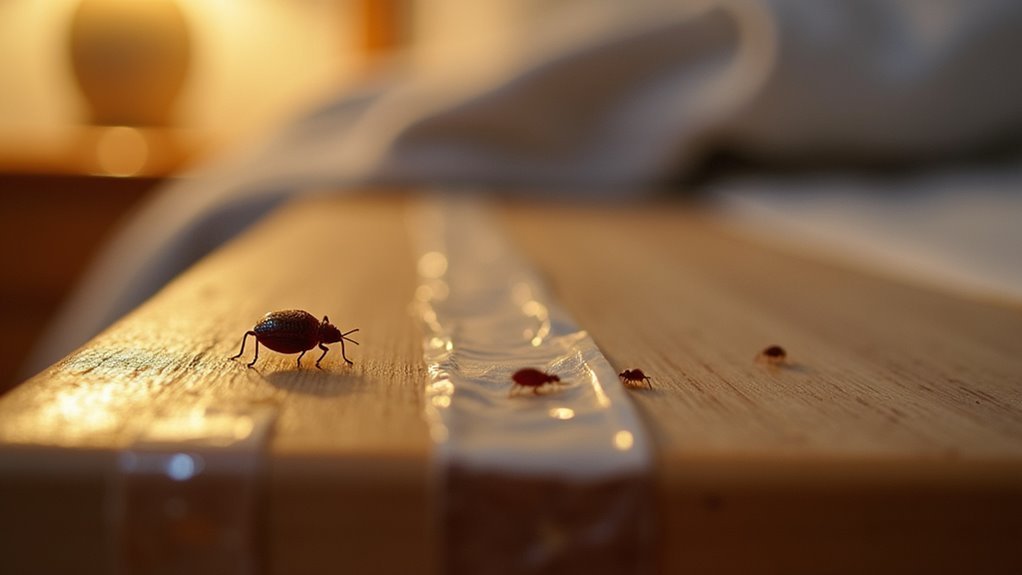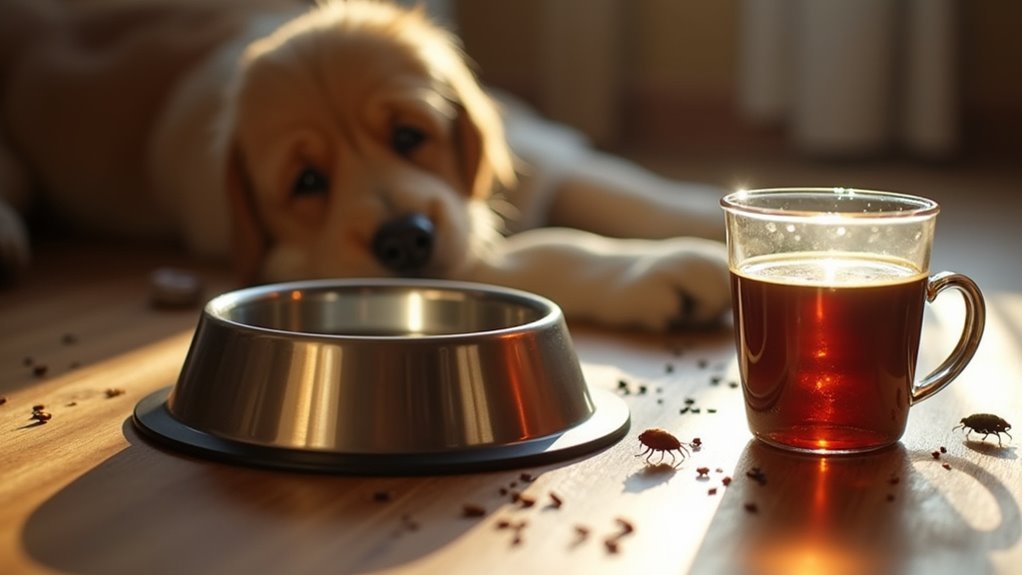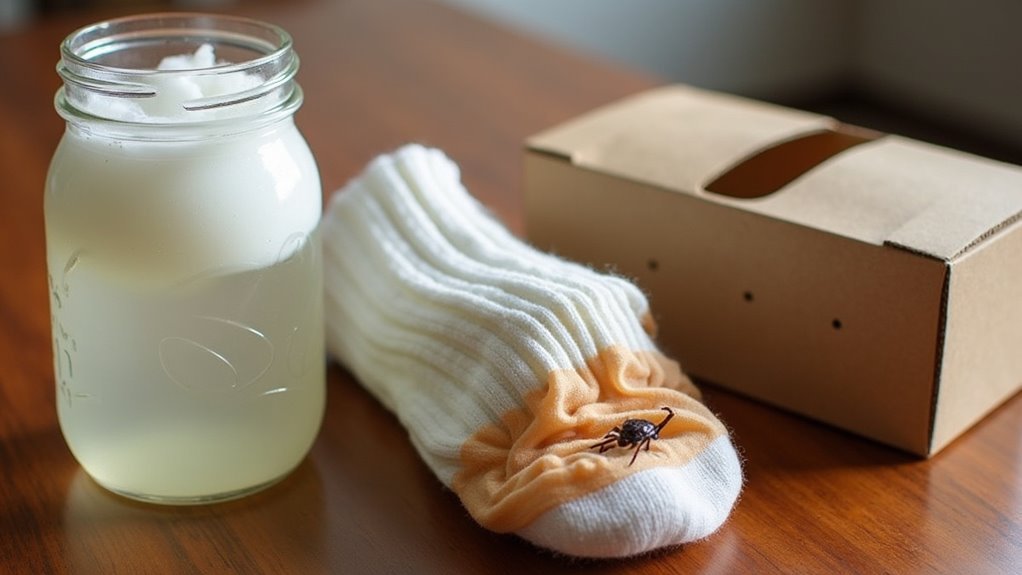You can create effective bed bug traps using five simple household methods: a sugar and yeast CO2 trap that mimics human breath, double-container interceptors placed under furniture legs, double-sided sticky tape along travel routes, cardboard box hiding places with CO2-soaked cloth, and a dog bowl monitoring system with coffee cups. These DIY solutions cost practically nothing and often outperform expensive commercial products. The complete setup instructions and strategic placement tips will transform your pest control approach.
The Sugar and Yeast CO2 Attraction Trap

When bed bugs invade your home, you can create an effective monitoring trap using common household ingredients that mimic human breath. This homemade sugar and yeast solution produces carbon dioxide that attracts bed bugs from considerable distances.
You’ll need 2 cups granulated sugar, 2 liters warm water, and 1/2 teaspoon yeast for the mixture.
Cut a 2-liter plastic bottle’s top off, wrap it with paper towels for grip, then invert the top into the base creating an entry funnel.
Add 1/4 cup sugar inside along with your sugar-yeast solution. This trap offers an affordable alternative to expensive extermination services while providing early infestation detection.
Replace the solution every three days to maintain effective carbon dioxide production and ideal bed bug capturing capability.
Double-Container Interceptor Trap Design
Another highly effective homemade solution involves creating a double-container interceptor trap that exploits bed bugs’ climbing limitations. This bed bug trap uses a smaller container nested inside a large container, creating an inescapable barrier once pests enter.
| Component | Purpose |
|---|---|
| Smaller Container | Entry point with rough-surfaced tape |
| Large Container | Smooth escape-proof barrier |
| Rough-Surfaced Tape | Allows easy climbing access |
| Smooth Surfaces | Prevents bed bug escape |
| Furniture Placement | Under legs for monitoring and trapping |
You’ll construct this trap out of common household items by applying rough-surfaced tape inside the smaller container while keeping the larger one smooth. This design effectively helps prevent bed bugs from escaping while enabling early detection. Place approximately fifty traps under furniture legs for thorough pest control coverage in a typical three-bedroom home.
Double-Sided Sticky Tape Capture Method

While container traps work exceptionally well for monitoring furniture legs, you can expand your bed bug detection strategy with double-sided sticky tape placed along baseboards, bed frames, and other travel routes.
This bed bug trap method captures bugs as they crawl across the adhesive surface, making it one of the most cost-effective household items for monitoring an infestation.
You’ll need to replace the tape regularly since dust and debris reduce its stickiness.
For enhanced effectiveness, sprinkle diatomaceous earth around your sticky tape traps to kill captured bugs and deter movement.
While these tape barriers won’t eliminate entire populations, they’re excellent for early detection and should complement other control measures for thorough infestation management.
Cardboard Box Hiding Place Trap
Since bed bugs naturally seek out dark, confined spaces during daylight hours, you can exploit this behavior by creating a simple cardboard box hiding place trap.
Place clean, dry cardboard boxes in strategic locations like under beds to monitor infestations effectively. This homemade trap requires no special materials, making it accessible for any homeowner.
To enhance your bed bug trap’s effectiveness, include a CO2-soaked cloth inside the box, which attracts these pests searching for hosts.
Once you detect bed bugs inside, immediately dispose of the entire cardboard box in a sealed plastic bag to prevent further spread.
Remember to regularly check and replace your traps to maintain their ability to detect bed bugs over time.
Dog Bowl and Coffee Cup Monitoring System

The dog bowl and coffee cup monitoring system transforms everyday household items into a powerful bed bug detection tool.
Transform ordinary household items into an effective bed bug monitoring system using simple materials you already have at home.
You’ll place an old coffee cup in the center of an upturned dog bowl, using the bowl’s shape to trap bed bugs that fall inside. This homemade trap doesn’t kill pests but excels at early detection, helping you identify infestations before they spread.
To maximize effectiveness, create this mixture:
- 150 grams of sugar
- 30 grams of yeast
- 1.5 liters of water
The fermentation process releases carbon dioxide that attracts bed bugs to your monitoring system.
Studies demonstrate this DIY design captures three times more bed bugs than leading commercial products.
You’ll appreciate its simplicity and low cost compared to expensive chemical solutions.
Frequently Asked Questions
What Is the Best Homemade Bed Bug Trap?
You’ll find the yeast and sugar trap most effective, mixing 150 grams sugar with 30 grams yeast in 1.5 liters water. It produces CO2 that attracts bed bugs better than commercial alternatives.
What Can I Use to Draw Bed Bugs Out of Hiding?
You can use a sugar-yeast mixture in warm water to produce CO2, which mimics your breath. Add spearmint oil for body scent simulation, and place black surfaces near beds to attract bed bugs effectively.
What Is the Best Homemade Bed Bug Killer?
You’ll create an effective homemade bed bug killer by mixing 150 grams sugar, 30 grams yeast, and 1.5 liters water. This produces carbon dioxide that attracts bugs to traps for monitoring and detection.
What Is the Best Attractant for Bed Bugs?
You’ll find carbon dioxide from fermenting sugar and yeast works best for attracting bed bugs. Add nonanal or 1-octen-3-ol to mimic human scent, and consider combining multiple attractants for maximum effectiveness.
In Summary
You’ve now got five effective DIY bed bug traps that’ll help you monitor and control these persistent pests. Don’t expect overnight results – bed bugs are clever survivors. You’ll need patience and consistency to see success. Combine these traps with thorough cleaning, regular inspection, and professional treatment if the infestation’s severe. Remember, early detection’s your best defense, so start monitoring today before the problem gets worse.





Leave a Reply